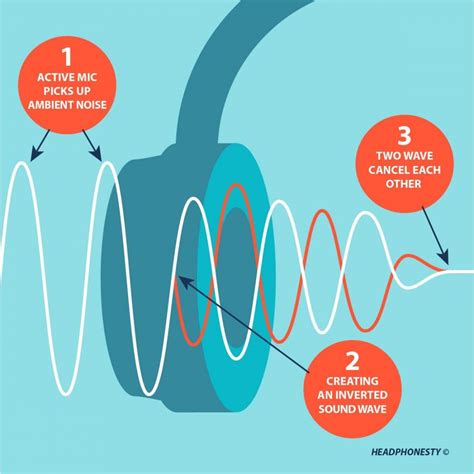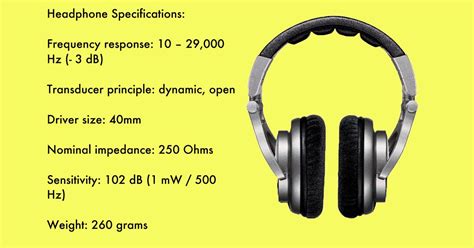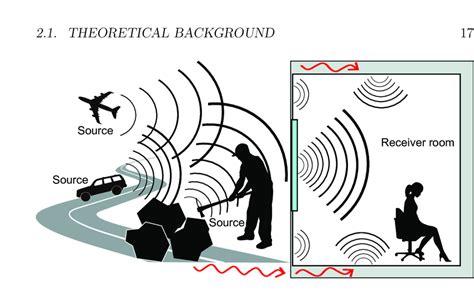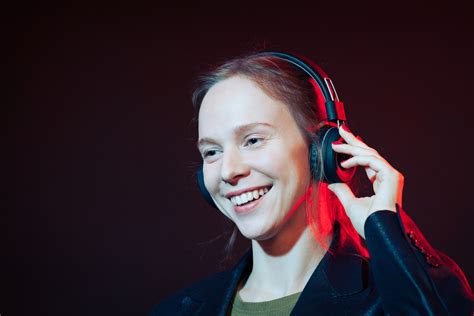When it comes to immersing yourself in the world of music, the quality of your audio equipment can make all the difference. You want to be able to enjoy every note, every beat, without any disturbance or interruption. One crucial feature to consider when selecting a pair of headphones is whether they possess the ability to block out unwanted sounds, allowing you to focus solely on the sounds that matter to you.
If you've ever found yourself in a situation where you couldn't fully immerse yourself in your favorite songs due to external disturbances, you may have wondered how certain headphones manage to provide that blissful tranquility. Fear not, for within this guide, we will explore the intricacies of noise isolation technology and equip you with the knowledge to determine whether your headphones can transport you to your own private concert hall.
Before delving into the specifics, it's crucial to understand that noise isolation and noise cancellation are not one and the same. While noise cancellation employs advanced technology to actively counteract external sounds, noise isolation takes a different approach. It relies on physical barriers, such as cushioned ear cups and snug-fitting designs, to passively block out unwanted noise. By creating a seal around your ears, these headphones work as a shield, shielding you from the outside world and allowing you to get lost in your auditory oasis.
Understanding the Concept of Noise Cancellation in Headphones

In the realm of audio technology, there exists a remarkable capability known as noise cancellation, a feature that goes beyond the mere delivery of sound. This intricate mechanism in headphones provides users with an immersive and distraction-free audio experience.
At its core, noise cancellation is a method employed by headphones to actively eliminate or reduce unwanted sounds from the environment. Instead of purely isolating the listener, this innovative technology utilizes a combination of hardware and software to counterbalance external noise, allowing the user to fully indulge in their desired audio content. By neutralizing extraneous sounds such as traffic noise, bustling chatter, or airplane engines, noise cancellation headphones create a tranquil auditory space for the user.
One key aspect of noise cancellation is the implementation of microphones. These tiny sensors detect the incoming ambient noise and generate a corresponding anti-noise signal. This signal is then combined with the audio signal delivered by the headphones, resulting in the cancellation or suppression of unwanted sounds. To achieve optimal noise cancellation, headphones may employ multiple microphones placed strategically on the outer casing or within the ear cups.
Additionally, noise cancellation technology can be categorized into two main types: passive and active. Passive noise cancellation relies on the physical design of the headphones, which serves as a barrier to external noise. The inclusion of cushioned ear cups or in-ear tips helps to create a seal or barrier, reducing the intrusion of unwanted sounds. On the other hand, active noise cancellation takes the process a step further by actively combatting the surrounding noise through the use of built-in electronics.
In conclusion, comprehending the concept of noise cancellation in headphones is essential for individuals seeking a heightened audio experience. By harnessing the power of microphones and advanced technology, noise cancellation headphones can effectively diminish the disturbances caused by external sounds, transforming any listening session into an oasis of tranquility and pure auditory enjoyment.
Types of Noise Cancellation Technologies
When it comes to blocking out unwanted sounds while enjoying your favorite music or audio, noise cancellation technology is essential. There are various types of noise cancellation technologies available in headphones today that allow you to experience a more immersive and uninterrupted listening experience.
| Noise Cancellation Technology | Description |
|---|---|
| Passive Noise Cancellation | This type of noise cancellation is achieved through the physical design of the headphones. By using materials and structures that block external noise, passive noise cancellation reduces the amount of noise that reaches your ears. It is commonly found in over-ear and in-ear headphones with good sound isolation properties. |
| Active Noise Cancellation (ANC) | Active noise cancellation technology uses microphones built into the headphones to detect external sounds. These headphones then generate anti-noise or sound waves with opposite frequencies to cancel out the incoming noise. ANC is particularly effective for low-frequency sounds, such as airplane engine noise or traffic rumble. |
| Adaptive Noise Cancellation | This advanced noise cancellation technology uses intelligent algorithms and multiple microphones to analyze the surrounding environment in real time. By continuously adjusting the level and type of noise cancellation, adaptive noise cancellation provides a personalized listening experience tailored to the specific noise conditions. |
| Hybrid Noise Cancellation | Hybrid noise cancellation combines both passive and active noise cancellation technologies. By using physical barriers to block out external noise and utilizing microphones to generate anti-noise, hybrid noise cancellation headphones offer a comprehensive solution for reducing unwanted sounds. |
Understanding the different types of noise cancellation technologies can help you make an informed decision when choosing headphones that best suit your preferences and listening environment. Whether you prefer passive noise cancellation for its simplicity or advanced adaptive noise cancellation for a tailored experience, there is a noise cancellation technology out there to enhance your audio enjoyment.
Examining the Headphone Specifications

When it comes to determining the capability of headphones to reduce external noises, it is crucial to examine their specifications. By carefully analyzing the technical details provided by manufacturers, one can gain insights into the effectiveness of noise cancellation technology integrated into the headphones.
One key specification to consider is the frequency response range. This refers to the range of frequencies that the headphones can reproduce. Headphones with a wider frequency response range are generally more capable of providing a rich and immersive audio experience. Additionally, a wider frequency response range often indicates the potential for better noise cancellation, as it suggests that the headphones are designed to eliminate a broad range of external sounds.
Another important aspect to examine is the driver size. The driver is the component responsible for converting electrical signals into sound waves. Generally, larger drivers are associated with better audio quality and potentially stronger noise cancellation abilities. This is because larger drivers are capable of producing more accurate and detailed sound reproduction, which can help in effectively canceling out external noises.
The type of noise cancellation technology employed by the headphones is also worth investigating. There are generally two types of noise cancellation: active and passive. Active noise cancellation (ANC) utilizes built-in microphones to detect external noises and then creates anti-noise signals to cancel them out. On the other hand, passive noise cancellation relies on the physical design of the headphones to block out external sounds. Understanding which type of noise cancellation is implemented by the headphones can provide insight into their effectiveness in reducing unwanted noise.
Finally, the battery life of headphones with active noise cancellation should be considered. ANC headphones require power to operate the noise cancellation technology, and a longer battery life ensures longer periods of uninterrupted noise cancellation. It is essential to review the battery specifications to ensure that the headphones will be able to provide noise cancellation for the desired duration.
| Specification | Importance |
|---|---|
| Frequency Response Range | High |
| Driver Size | Significant |
| Noise Cancellation Type | Crucial |
| Battery Life | Important |
Testing the Headphones in a Noisy Environment
When it comes to evaluating the effectiveness of noise cancellation in headphones, it is essential to assess their performance in a real-world scenario. This can be achieved by subjecting the headphones to a noisy environment and observing their ability to reduce or eliminate the ambient noise.
A suitable approach for testing headphones in a noisy environment involves creating a controlled setting that mimics typical everyday situations where noise cancellation may be desired. This can include settings such as a bustling city street, a crowded coffee shop, or a busy office environment.
During the testing process, it is important to ensure that all external audio sources are eliminated or carefully controlled to avoid interference with the evaluation. The headphones should be worn as instructed by the manufacturer, and the audio playback should be set to a moderate volume level.
| Testing Factors | Procedure |
|---|---|
| Ambient Noise Level | Measure the baseline noise level in the testing environment using a decibel meter. |
| Noise Cancellation On | Engage the noise cancellation feature of the headphones and play various soundtracks featuring different frequency ranges, including low, mid, and high frequencies. Evaluate the reduction in ambient noise and the clarity of the audio being played. |
| Noise Cancellation Off | Disable the noise cancellation feature and play the same soundtracks. Assess the ability of the headphones to block out or minimize external noise without noise cancellation. |
| Comfort and Fit | Take note of the comfort and fit of the headphones during the testing process. Evaluate whether the headphones seal snugly around the ears to enhance noise isolation. |
By conducting a comprehensive evaluation based on these factors, it becomes possible to determine the effectiveness of a headphone's noise cancellation capabilities in a noisy environment. This information can guide potential buyers in selecting the most suitable headphones for their needs and preferences.
Assessing the Capability to Reduce Ambient Noise

When evaluating the capability of headphones to diminish the impact of ambient noise, it is important to consider various factors. These elements contribute to the overall effectiveness of noise reduction and provide insight into the performance of the headphones in different environments.
One crucial aspect to examine is the ability of the headphones to suppress sounds originating from the surroundings. This can be achieved through active noise cancellation technology or passive noise isolation mechanisms. Active noise cancellation employs microphones and electronic circuitry to detect ambient noise and generate counteracting sound waves, while passive noise isolation relies on the physical design of the headphones to block out external sounds.
Additionally, the frequency range in which ambient noise reduction is most effective should be taken into account. Different headphones may excel at reducing noise in specific frequency ranges, such as low-frequency rumbling or high-pitched sounds. Understanding the frequency response of the headphones allows for a better assessment of their performance in different noise environments.
Moreover, it is crucial to evaluate the degree of comfort provided by the headphones during use, as this can impact their ability to effectively reduce ambient noise. Headphones that fit securely and snugly over the ears help minimize the infiltration of external sounds, thereby enhancing the overall noise cancellation experience.
Furthermore, considering the durability and build quality of the headphones is essential. Sturdy construction and effective sealing of the ear cups contribute to better noise reduction by preventing sound leakage and maximizing the effectiveness of active or passive noise cancellation methods.
In conclusion, assessing the ambient noise reduction capability of headphones involves evaluating factors such as the type of noise reduction technology employed, the frequency range of noise reduction, comfort during use, and the overall durability and build quality. By considering these aspects, one can make an informed decision when selecting headphones that effectively minimize ambient noise and enhance the listening experience.
Comparing Active and Passive Noise Cancellation
In the realm of noise reduction technology, there are different approaches employed by headphones to minimize unwanted external sounds. This section will explore the key differences between active and passive noise cancellation methods, shedding light on their respective advantages and limitations.
Active Noise Cancellation:
Active noise cancellation technology involves the use of built-in microphones and circuitry within the headphones. These microphones constantly analyze and measure ambient sound waves, before generating an "anti-noise" signal to counteract the incoming noise. The generated anti-noise is then mixed with the audio signal, effectively reducing the overall level of external noise reaching the listener's ears. This active noise cancellation method requires power from a battery or an external power source to function.
Active noise cancellation has several notable advantages. It is particularly effective in reducing low-frequency sounds, such as engine noises and traffic rumble, providing a more immersive audio experience. It also allows for customization, with many headphones offering different levels or modes of noise cancellation. However, it is worth noting that active noise cancellation may introduce a faint hissing sound, known as "white noise," which some users may find slightly distracting.
Passive Noise Cancellation:
Unlike its active counterpart, passive noise cancellation does not rely on electronic components or power sources. Instead, it utilizes physical design elements and materials to block or absorb external noise. Passive noise cancellation headphones typically employ features such as thick ear cups, tight seals, and soundproofing materials, which create a physical barrier between the user's ears and the surrounding environment.
Passive noise cancellation offers a simple and immediate solution for reducing unwanted noise without the need for additional power. It is most effective against high-frequency sounds, such as chatter or office conversations, as well as ambient noises like the hum of air conditioning or fans. However, passive noise cancellation may not be as effective as active noise cancellation in blocking out low-frequency sounds or sudden spikes in noise levels.
In conclusion, both active and passive noise cancellation methods have their own strengths and weaknesses. Active noise cancellation excels in reducing low-frequency sounds and provides customizable options, but it may introduce a faint background hiss. On the other hand, passive noise cancellation offers simplicity and effectiveness against high-frequency noises but may not be as effective in blocking out low-frequency sounds. The choice between the two ultimately depends on the specific needs and preferences of the user.
Evaluating User Feedback and Professional Assessments

Understanding the collective judgment of consumers and experts can provide valuable insights when determining if headphones offer effective noise cancellation capabilities. By analyzing consumer reviews and expert opinions, one can gain a comprehensive understanding of various headphone models and their noise cancellation performance.
When exploring user feedback, it is essential to consider the overall sentiments expressed by consumers regarding the headphones' noise cancellation features. Pay attention to recurrent keywords and phrases that indicate satisfaction or dissatisfaction with noise isolation. User experiences can vary, so evaluating a substantial number of reviews provides a more accurate assessment.
Expert assessments offer a more in-depth analysis of headphones' noise cancellation capabilities. Professionals meticulously test and compare different models, considering factors such as noise reduction effectiveness, audio quality, fit, comfort, and battery life. Expert reviews often provide detailed explanations and measurements, making them a reliable source of information.
It is crucial to look for consistency between user feedback and expert evaluations. If a particular headphone consistently receives positive reviews regarding noise cancellation from both consumers and experts, it is likely to offer effective noise isolation. Conversely, if there are widespread complaints about noise leakage or reduced performance, it may be wise to consider alternative options.
In addition to considering overall impressions, look for specific details mentioned in user reviews and expert assessments. Pay attention to situations or environments in which the noise cancellation is praised or criticized. Assessing whether the headphones excel at blocking ambient noise in specific scenarios can help determine if they are suitable for your intended use.
- Take note of any recurring complaints or compliments related to the headphones' noise cancellation.
- Compare multiple user reviews and expert opinions to get a broader perspective.
- Consider the reputation and credibility of the sources providing the feedback.
- Look for consistency between user experiences and expert evaluations.
- Make a note of specific scenarios in which the noise cancellation is reported to be particularly effective or ineffective.
Considering the Price-Quality Ratio of Noise-Reducing Headphones
When it comes to purchasing noise-canceling headphones, it is essential to weigh the price-quality ratio. This factor can significantly impact the overall satisfaction and performance of the headphones. By considering the price-quality ratio, buyers can make informed decisions and choose headphones that align with their preferences and budget.
| Key Factors | Price-Quality Relationship |
|---|---|
| Brand Reputation | High-end brands often offer better noise-canceling technology and overall build quality, but at a higher price point. However, mid-range and budget-friendly options can still deliver satisfactory noise reduction. |
| Sound Quality | While noise-canceling capabilities are crucial, it is equally important to consider the overall audio quality. High-quality headphones with noise cancellation technology may cost more but provide a superior listening experience. |
| Comfort | Comfort plays a significant role in long-term usage. Higher-priced headphones often feature superior materials, padding, and adjustable features that enhance comfort during extended periods of wear. |
| Battery Life | Considering the price-quality ratio also involves evaluating the battery life of noise-canceling headphones. While premium options tend to have longer battery life, mid-range headphones can offer a satisfactory duration at a more affordable price. |
| Additional Features | Some higher-priced noise-canceling headphones may include extra features such as built-in smart assistants, touch controls, or customizable equalizers. While these features can enhance the user experience, they also increase the cost. |
| Warranty and Customer Support | Considering the price-quality ratio involves evaluating the warranty and customer support provided by different headphone brands. High-end options typically offer more comprehensive warranties and reliable customer service. |
Remember, the price-quality ratio is not solely focused on getting the cheapest headphones, but rather finding a balance between the desired level of noise reduction, overall audio quality, comfort, and additional features within a specified budget. By assessing these factors, individuals can determine the best noise-canceling headphones that offer both value and performance.
Understanding the Limitations of Noise-Canceling Headphones

Exploring the boundaries and constraints of noise-canceling headphones allows users to make informed decisions when selecting the appropriate audio equipment. While noise-canceling technology aims to minimize external sounds, it is essential to recognize its limitations and understand that it may not completely eradicate all noise.
Noise isolation versus active noise cancellation:
Noise isolation and active noise cancellation are two different methods of reducing unwanted sounds. Noise isolation refers to the physical design of the headphones, which helps to block out external noises by creating a physical barrier between the ears and the environment. On the other hand, active noise cancellation involves the use of electronic circuitry to analyze ambient noise and generate an opposing sound wave to cancel it out. It is important to determine which method a headphone uses, as this can affect its effectiveness in certain situations.
Limitations of noise-canceling headphones:
While noise-canceling headphones can significantly reduce constant low-frequency sounds like airplane engines or air conditioners, they may struggle to eliminate sudden, high-pitched noises or irregular sounds. Certain noise-canceling models may also have difficulty canceling out sounds with multiple frequencies or sounds occurring very close to the ears.
External sounds leakage:
Noise-canceling headphones are designed to create an immersive audio experience by blocking out external noise. However, it is important to note that some sound leakage may occur, particularly at high volumes. This can be a concern if using headphones in public spaces or in shared environments where others may be disturbed by the audio being played.
Battery life and audio quality:
Noise-canceling technology requires power to function, and this power is typically supplied by a built-in battery. Users should consider the battery life of the headphones to ensure they can sustain adequate noise cancellation for their intended use. Additionally, some users may notice a slight reduction in audio quality when noise-canceling features are activated, as the cancellation process can interfere with the overall sound reproduction.
By understanding the limitations of noise-canceling headphones, individuals can make informed decisions about their audio needs and select headphones that best suit their preferences and environments.
The Significance of Trying Headphones Before Making a Purchase
When it comes to purchasing headphones, one of the most crucial aspects to consider is trying them out before finalizing your decision. This step holds immense importance in ensuring that you choose the right pair of headphones that meet your specific needs and preferences.
Trying out headphones before buying allows you to experience their sound quality, comfort, and overall performance firsthand. It gives you the opportunity to assess whether the headphones effectively block out external noise, provide an immersive audio experience, and fit comfortably over your ears.
By physically trying out headphones, you can gauge the level of noise cancellation they offer, ensuring that they meet your requirements. This step is particularly significant for individuals who frequently find themselves in noisy environments and rely on headphones to enjoy uninterrupted sound.
Furthermore, trying headphones before purchasing also allows you to evaluate their build quality, durability, and design. You can examine the materials used, check the sturdiness of various components, and determine whether the headphones are visually appealing to you.
In addition, trying out headphones beforehand helps you assess their compatibility with your devices. It allows you to test whether the headphones can be easily connected to your preferred audio sources and devices, ensuring a seamless user experience.
Ultimately, trying headphones before making a purchase is a fundamental step to guarantee that you invest in a pair that fulfills your individual requirements and provides an optimal listening experience. It allows you to make an informed decision based on personal preferences and ensures that you are satisfied with your purchase in the long run.
[MOVIES] [/MOVIES] [/MOVIES_ENABLED]FAQ
What is noise cancellation in headphones?
Noise cancellation in headphones refers to a technology that actively blocks out external noise, allowing the listener to hear only the sound from the headphones themselves. This technology helps to create a more immersive and high-quality audio experience.
How does noise cancellation work in headphones?
Noise cancellation in headphones operates using a combination of built-in microphones and advanced signal processing algorithms. The microphones detect external ambient noise, and the algorithms generate sound waves that effectively cancel out those noises, resulting in a quieter listening environment.
Are all headphones equipped with noise cancellation technology?
No, not all headphones come with noise cancellation technology. Noise cancellation is commonly found in higher-end headphones, especially those designed for professional or premium audio usage. However, there are also budget-friendly options available that offer noise cancellation features.
How can I determine if headphones have noise cancellation?
To determine if headphones have noise cancellation, look for labels or product descriptions that explicitly mention the presence of noise cancellation technology. Additionally, you can check for physical features such as built-in microphones and switches that control the noise cancellation function. Reading customer reviews and expert opinions can also provide valuable insights into a headphone's noise cancellation capabilities.
What are the benefits of using headphones with noise cancellation?
Using headphones with noise cancellation provides several benefits. Firstly, it allows for a more immersive listening experience by eliminating background noise. Secondly, it can protect your hearing by allowing you to listen to audio at lower volumes. Additionally, noise cancellation can be highly beneficial in noisy environments such as airplanes or busy city streets, as it allows you to enjoy your audio without compromising the sound quality.




